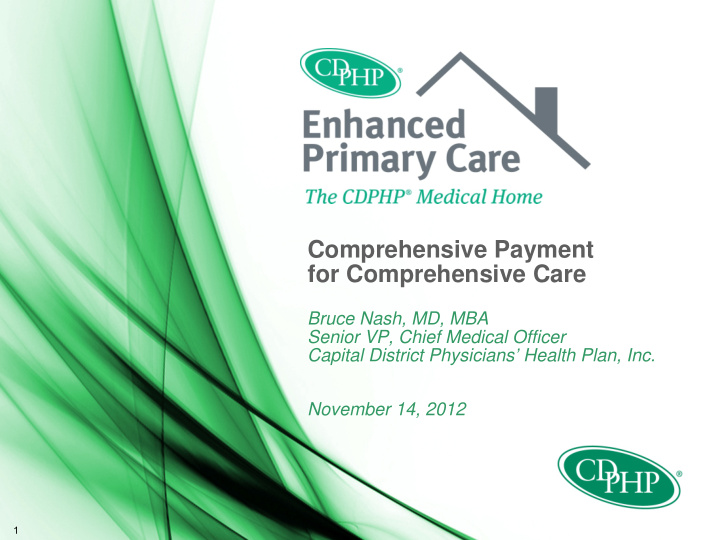



Comprehensive Payment for Comprehensive Care Bruce Nash, MD, MBA Senior VP, Chief Medical Officer Capital District Physicians’ Health Plan, Inc. November 14, 2012 1
About CDPHP • Founded by local physicians more than 25 years ago • 24-county service area in upstate NY • 1,000 employees • 400,000 members: − Commercial − Medicare − Medicaid/State Programs 2
Enhanced Primary Care (EPC) Program History • Five years ago CDPHP recognized primary care to be in crisis – Primary care did not offer a competitive earning potential to attract the interest of graduating medical students – Projected shortage of primary care physicians • CDPHP recognized the need to design a payment model that – would support enhanced reimbursement to primary care practices – make the practice of primary care more attractive to medical students and practicing physicians 3
Payment Reform Practice Reform 4
Pilot Practices • Latham Medical Group (5,911) – 8.85 physicians; 1 PA • Community Care – Schodack (2,330) – 3.75 physicians; 1 NP; 1 PA • Capital Care – Clifton Park (3,295) – 3 physicians; 3 NPs Practice selection criteria: 1. Significant number of CDPHP members 2. Already had EHR installed 3. Physician thought of as leader in the community 5
Pilot Results 2008-2010 Increase 2009 / 2011 6
Pilot Results 2008-2010 Source: Verisk Health- Arlene Ash, PhD, University of Massachusetts Medical School; 7 Randy Ellis, PhD, Boston University
EPC Payment Model Base • Severity adjusted capitation for services directly provided • Reimburses 23% higher than fee-for-service for codes covered under the capitation FFS • Billing codes not covered under capitation • Patients who are not yet on the capitation roster • Other: non-cap physician office labs, immunizations, etc. • Administrative services only (ASO) group members Bonus • Triple Aim • Potential bonus determined by illness burden and number of members • 1,800 CDPHP members with an average illness burden would fund a potential annual bonus of $115,000 8
EPC Payment Model % % 0 0 4 4 ~ ~ Bonus Adjustment PIP Care Coordination Capitation FFS FFS 9
Payment Model Value Creation • Pays more for sicker patients to allow more time with them as well as coordinate their care • Allows for the practice to decide how to best care for certain patients – e.g., doesn’t require them to be seen by MD for every service • Allows practice to develop non-face-to-face visit care models such as telephone, e-visits, or secure email as appropriate • Supports an “evidence-based medicine” mindset – Is each visit or service that is ordered truly necessary? – Is there a better way to ensure all needed services are delivered to the population? 10
The Evolution of the EPC Program # Of Practices # Of # Of Clinicians Members 3 30 12,032 Phase I (Pilot) 2009 23 149 40,672 Phase II 2010 50 230 45,542 Phase III 2011 64 244 67,212 Phase IV 2012 21 70 15,554 CPCI 2012 161 723 181,012 Total: 11
Future • Currently 19 practices of the Phase I and II cohorts are in the EPC payment model • Commonwealth Fund external analysis March 2012 - February 2013 • Deployment of CDPHP clinical resources into the practices • Investments in health information technology • Analytics to support clinical improvement 12
Lessons Learned 13
Thank you 14
Recommend
More recommend